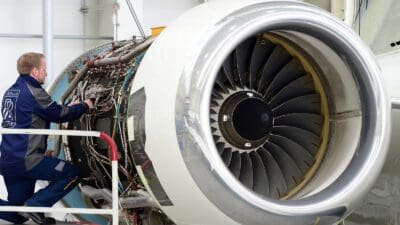Rolls-Royce (LSE:RR) shares have threatened to recover a few times this year. However, over the past month, they are falling again. In fact, the stock is down 9% over the past month and its currently down 25% over the previous 12 months.
I already own Rolls-Royce shares, and they haven’t done overly well for me. However, I’m still bullish on this British engineering giant. So let’s take a closer look at Rolls and why I’d add more of this stock to my portfolio at 83p.
Recent performance
Rolls-Royce’s recent investor update didn’t appear to please shareholders. In early August, the firm reported a drop in first-half underlying operating profit. However, it reiterated its backing for its full-year guidance amid expectations of an improvement in the civil aerospace division.
Underlying operating profit fell to £125m from £307m in the same period a year ago.
One of the reasons presented for the fall in profits was new investments. The dip in operating profit was due to lower underlying gross profit and included £371m in research and development costs with an increase in defence, power systems and new markets spending. This is being balanced by lower outlay in civil aerospace — the firm’s largest business segment.
There were some positives. Rolls highlighted a recovery of flying hours in civil aviation, a strong order book in defence and record order intake in power systems.
Outlook
I’m pretty bullish on the outlook for Rolls-Royce, but debt does concern me. The business had net debt of £5.1bn as of June, but the shedding of some business units should help reduce that figure. With interest rates rising, repayments could be pushed up. So getting this debt down to manageable levels is of the upmost importance.
The debt burden increased substantially during the pandemic as civil aviation paused and the income Rolls received from flying hours was slashed.
But civil aviation isn’t Rolls’ only business segment. Last year, it generated £4.5bn from its civil aerospace division, while £3.3bn came from defence, and £2.8bn came from power systems.
However, there are clearly signs civil aviation is returning to pre-pandemic levels despite the near issues around the so-called “travel chaos“. Moreover, the war in Ukraine and increased defence spending worldwide should see sustained demand for its defence segment.
In the longer run, I also contend that Rolls-Royce operates in sectors where quality comes at a real premium. As a result, I’d suggest that emerging market players would struggle to take market share from Rolls or its American peers.
And these factors are core to my bullishness. Rolls-Royce is still generating sizeable revenues. The company currently has a price-to-sales ratio of around 0.5. This is low, but does also reflect the impact of debt on the share price.
I’d buy more Rolls-Royce stock and hold it for the long run.








